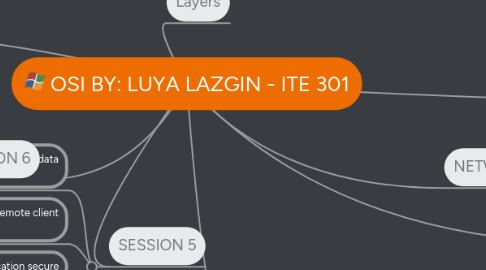OSI BY: LUYA LAZGIN - ITE 301
by After Math


1. SESSION 5
1.1. Firstly, it maintains connection for ondoing data sxchange between two nodes
1.2. Usually, conection is between a remote client and an access servrer
1.3. Moreover, it keeps communication secure
1.4. Finally, it determines if communications have been cut off, and also figuing out how to reconnect them it they have been disconnected
2. PRESENTATION 6
2.1. This layer accepts application layer data and formats it into unserstandable data for another application and hose
2.2. Also, it encodes information into a more compresses format.
2.3. Moreover, it interprets encoded informtion
2.4. it also translates the encodes in order to be read
2.5. Finally, it handels data encryption such as scrambling of passwords and decryption
3. Application Layer 7
3.1. the 7th layer
3.2. The user interacts with the software
3.3. Web server response includes text, graphics and specification for content contained on the page requested
3.4. It formats web servers response back to clients browser
3.5. It sends request from the client broweser to the server
3.6. Also, it uses the protocol HTTP to interpret web serves response
4. Layers
5. PHYSICAL 1
5.1. It accepts frames from the data link layer and generates signals by the NIC
5.2. when the data is recived, the data get translated by the data link layer
5.3. it monitors data errors but cannot preform error connection
6. DATA LINK 2
6.1. Divides data recived by the network into frames
6.2. it ensures that the data at its destination matches its source data exactly
6.3. if the check fails, the data is re-transmitted to the destination
7. NETWORK 3
7.1. FIRSTLY, it translates network addresses into their physical counterparts
7.2. Selects the route data between the sender and reciever
7.3. Adds logical address information in a network header
8. TRANSPORT 4
8.1. It accepts data from the layer before it
8.2. Manges flow control
8.3. It uses Transmission Control Protocol
8.3.1. in which Three Hand Shakes is used

